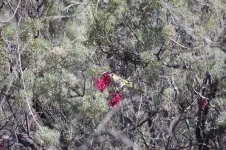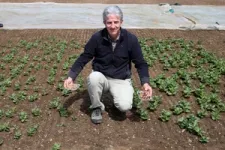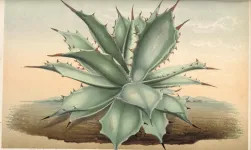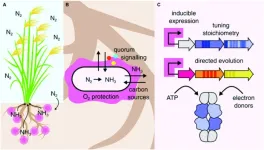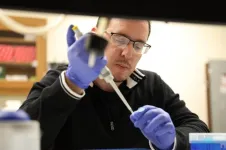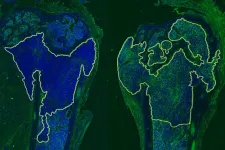(Press-News.org) Curtin researchers have uncovered new evidence of western pygmy possums interacting with native flowers, providing the first eDNA study to simultaneously detect mammal, insect and bird DNA on flowers.
The new research, published today in Environmental DNA, examined DNA traces left by animal pollinators on native flora and detected both insect and animal pollinators from multiple flowering plant species at once - a game changer in the face of declining animal pollinators globally.
In North America, some pollinator species have fallen by more than 95 per cent while native plant species across America have declined between three and 50 per cent. In some parts of Europe, wild pollinator diversity has more than halved and one in three bee, butterfly and hoverfly species are disappearing.
Lead author Joshua Newton, a PhD candidate in Curtin’s School of Molecular and Life Sciences, said the research offered new scientific evidence to support the use of environmental DNA as a tool to help survey and monitor plant-animal interactions.
“We know the significant role that animal pollinators play in the reproduction of about 90 per cent of flowering plants, but this crucial relationship is under threat as many of these species are experiencing declines across the globe,” Mr Newton said.
“That means effective pollinator monitoring methods are now more important than ever before, as we search for new, fast and accurate ways of safeguarding the future of endangered flora.”
The study identified five mammals including the surprising western pygmy possum, eight bird species including singing honeyeaters and yellow-throated miners, and 57 arthropods including moth families that had not previously been recorded as flower visitors.
Project lead Associate Professor Paul Nevill, from Curtin’s School of Molecular and Life Sciences, said better methods to monitor pollinators were desperately needed given their ongoing declines.
“This disruptive technology is in the early stage of application in terrestrial systems, and will not only allow us to detect pollinators but multiple other species – for example, pests and invasive species – that interact with plants,” Associate Professor Nevill said.
“eDNA offers an opportunity to explore and monitor ecosystems at multiple levels - not just what we are able to easily see, hear and identify under a microscope.”
Co-author Associate Professor Bill Bateman, also from Curtin’s School of Molecular and Life Sciences, said the metabarcoding of eDNA traces was able to detect interactions between pollinators and flowers.
“We were especially pleased to find evidence of a western pygmy possum visiting a flower because at the time it was the first eDNA metabarcoding based identification of an interaction of a mammal or bird species with flowers, to our knowledge,” Associate Professor Bateman said.
“This finding shows us that the eDNA metabarcoding of flowers offers a more complete set of floral visitors and may prove an effective tool for monitoring rare plant species that are growing in remote regions, receive relatively few pollinator visits, or are visited by cryptic animal species.”
In this study, the native flowers that attracted the greatest diversity of animal visitors were the larger more generalist flower types, Banksia arborea, commonly known as Yilgarn dryandra, and Grevillea georgeana.
The research was carried out in the Helena and Aurora Range, also known as Bungalbin, located in the Great Western Woodlands west of Kalgoorlie in the Goldfields-Esperance region of Western Australia.
Funded by Mineral Resources Limited (MinRes), it also involved other researchers from Curtin University and Edith Cowan University.
The full paper, titled ‘Monitoring the birds and the bees: environmental DNA metabarcoding of flowers detects plant-animal interactions’, is available online here.
END
eDNA holds the key to safeguarding pollinators amid global declines: Study
2023-03-08
ELSE PRESS RELEASES FROM THIS DATE:
SIAM Conference on Computational Geometric Design (GD23)
2023-03-08
The 2023 SIAM Conference on Computational Geometric Design, organized by the SIAM Activity Group on Geometric Design, is part of the International Geometry Summit bringing together the Symposium on Physical and Solid Modeling 2023, Shape Modeling International 2023, EG Symposium on Geometry Processing 2023, and Geometric Modeling and Processing 2023.
The 2023 SIAM Conference on Computational Geometric Design seeks high quality, original research contributions that strive to advance all aspects ...
Study associates long COVID with physical inactivity
2023-03-08
The link between symptoms of COVID-19 and physical inactivity is increasingly evident. An article recently published in the journal Scientific Reports by researchers at the University of São Paulo (USP) in Brazil describes a study in which COVID-19 survivors with at least one persistent symptom of the disease were 57% more likely to be sedentary, and the presence of five or more post-acute sequelae of infection by SARS-CoV-2 increased the odds of physical inactivity by 138%.
“Although this was a cross-sectional study, the findings underscore the importance of discussing and encouraging physical activity at all times, including during the pandemic,” ...
Scientists uncover the unexpected identity of mezcal worms
2023-03-08
Mezcal is a distilled alcohol made from the boiled and fermented sap of agave plants. Most mezcal beverages — including all brands of tequila — are sold as pure distillates, but a few have an added stowaway bottled inside: worms.
Called gusanos de maguey (Spanish for agave worms), these odd organic chasers aren’t actually worms, but instead a type of insect larva, and their addition to mezcal is a recent one. Mezcal production has a storied history, dating back to the first Spanish inhabitants of Mexico, but larvae were only added to the drink in ...
AERA announces 2023 fellows
2023-03-08
WASHINGTON, March 8, 2023—The American Educational Research Association (AERA) has announced the selection of 24 exemplary scholars as 2023 AERA Fellows. The AERA Fellows Program honors scholars for their exceptional contributions to, and excellence in, education research. Nominated by their peers, the 2023 Fellows were selected by the Fellows Committee and approved by the AERA Council, the association’s elected governing body. They will be inducted during a ceremony at the 2023 Annual Meeting in Chicago on April 14. They join a total of 714 AERA Fellows.
“AERA Fellows demonstrate the highest standards ...
A better way to produce fertilizers
2023-03-08
Fertilizers are one of the main reasons that we are able to grow enough crops to feed the almost 8 billion humans living on Earth. Modern agriculture depends largely on nitrogen-based fertilizers, which significantly increase the yield of crops. Unfortunately, a great portion of these fertilizers are produced at an industrial level, consuming fossil fuel energy and causing nitrogen pollution.
One attractive way to minimize our use of industrially produced fertilizers is to harness the power of nitrogenases. ...
University of Cincinnati study finds little federal funding for incarceration-related research
2023-03-08
Research from the University of Cincinnati finds a lack of federal funding for incarceration-related research. The study looked at data from the Department of Justice, National Institutes of Health (NIH) and National Science Foundation, some of which dated back to 1985.
The study was published recently in the journal JAMA Network Open.
“We have very little evidence-based research on how and when to intervene with children and families when someone is removed from the home due to incarceration, especially on how to ...
How nanoplastics can influence metabolism
2023-03-08
PET, the plastic used to make bottles, for example, is ubiquitous in our natural environment. In a joint study, scientists from Leipzig University and the Helmholtz Centre for Environmental Research (UFZ) investigated the negative effects that tiny plastic PET particles can have on the metabolism and development of an organism. Their findings have now been published in the journal Scientific Reports.
The increasing use of plastic is threatening ecosystems around the world. One of the big concerns is the presence of plastics in the form of small particles, also called microplastics and nanoplastics. ...
Virginia Tech researchers study PTSD effects on bystanders
2023-03-08
The traditional line of thought is that post-traumatic stress disorder (PTSD) is caused by directly experiencing the traumatic event. However, about 10 percent of diagnosed PTSD occurs when people witness these events versus experiencing it directly themselves.
Little is known about these cases of PTSD, but that’s something that Tim Jarome, an associate professor in the College of Agriculture and Life Sciences School of Animal Sciences, is aiming to change with a $430,000 grant from the National Institute ...
New pain medications are still widely inaccessible to individuals living with sickle cell disease
2023-03-08
(WASHINGTON, March 8, 2023) – Sickle cell disease (SCD), a rare chronic, progressive, life-threatening, inherited blood disorder, often affects individuals with chronic pain that can be debilitating to their quality of life. Yet less than 4% of people living with SCD who experience chronic pain episodes have prescriptions for newer FDA-approved pain-relieving drugs, including l-glutamine, voxelotor, and crizanlizumab, according to a new study published in Blood Advances. Further, researchers found that less than a third of patients with pain episodes have prescriptions for hydroxyurea, ...
Two-pronged immunotherapy eliminates metastatic breast cancer in mice
2023-03-08
Metastatic breast cancer has no cure and has proven stubbornly resistant to one of the most innovative and promising new cancer treatments: immunotherapy.
Now, researchers at Washington University School of Medicine in St. Louis have identified a way to treat the area surrounding breast tumors that have spread to bone so that such tumors become vulnerable to attack by the body’s immune system. When the researchers boosted the activity of certain immune cells, called T cells and macrophages, these immune cells worked together to clear metastatic breast tumors that had spread to the bones of mice, and continued to eliminate tumor cells ...
